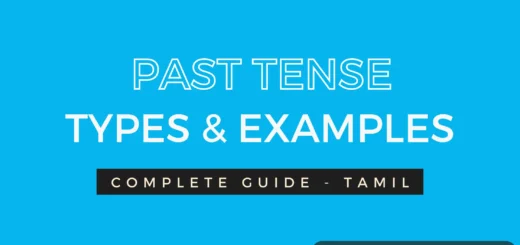Direct & Indirect speech (நேர்க்கூற்று அயற்கூற்று) in Tamil
Direct speech and Indirect speech ஆனது தமிழில் நேர்கூற்று மற்றும் அயற்கூற்று என அழைக்கப்படுகிறது.
நாம் பேசிய ஒன்றையோ அல்லது வேறு ஒருவர் கூறியதை மற்றொருவரிடம் கூறும் போது நாம் நேர்கூற்று மற்றும் அயற்கூற்று உபயோகிப்போம்.

Direct speech (நேர்கூற்று)
நாம் பேசியதை, நாம் பேசியவாறே திரும்ப கூறும்போது அல்லது வேறு ஒருவர் பேசியதை அப்படியே அவர் பேசியவாறே குறிப்பிட நேர்கூற்று வாக்கியங்கள் உதவுகின்றன.
நாம் இங்கு Quotation mark (மேற்கோள் குறி) யினை உபயோகிப்போம் இந்த மேற்கோள் குறிக்குள் பேசியவர் பேசியதை அப்படியே குறிப்பிட வேண்டும்.
Examples
He says, “she loves chocolates”
She said, “we are going to watch a movie”
மேலே குறிப்பிடப்பட்டுள்ள எடுத்துக்காட்டுகளின்படி அவள், அவன் என்ன கூறினானோ, கூறினாலோ அதை அப்படியே வார்த்தை மாறாமல் குறிப்பிடப்பட்டுள்ளது. இத்தகைய வாக்கியங்கள் நேர்கூற்று வாக்கியங்கள் என அழைக்கப்படுகிறது.
Indirect speech (அயற்கூற்று)
அயற்கூற்று வாக்கியம் ஆனது வேறு ஒருவர் கூறியதை அவர் கூறியவரே கூறாமல் அவர் கூறியதை பொருள் மாறாமல் கூறுவது அதாவது அவர் இவ்வாறு சொன்னார் என்ற தகவலை வேறொரு காலத்தில், அல்லது வேறொரு இடத்தில் கூறுவது
இதில் நாம் Quotation mark (மேற்கோள் குறி)யினை உபயோகிக்க மாட்டோம். ஆனால், இதில் Punctuations (நிறுத்தற்குறிகள்) மாறுபடும்.
Examples
he says that he loves chocolate
she said that they were going to watch a movie
மேலே கூறியுள்ள எடுத்துக்காட்டுகளானது direct speech இன் எடுத்துக்காட்டுகளை Indirect speech ஆக மாற்றினால் கிடைப்பதை குறிப்பிடப்பட்டுள்ளது.
Direct speech ஐ Indirect speech ஆக மாற்றுவது எப்படி?
ஒரு வாக்கியத்தை Direct speech ஐ Indirect speech ஆக மாற்ற reporting verb, tense, pronoun, conjunction, adverbial ஆகியவற்றை மாற்ற வேண்டும்.
எப்படி அதை மாற்ற வேண்டும் எத்தகைய சூழ்நிலைகளில் அதை மாற்ற வேண்டும் என்பதை இங்கு விரிவாக காண்போம்.
1. Reporting verb and Conjunctions change
இந்த Reporting verb ஆனது வாக்கியத்தின் வகையைப் பொறுத்து மாறும். நான்கு வகையான வாக்கியவகைகளை பற்றியும் அவை எப்படி மாறும் என்பதையும் காண்போம்.
1. Statement sentence – சாதாரண வாக்கியம்
Reporting verb
| Direct Speech | Indirect Speech |
| Says | Says |
| Says to | Tells |
| Said | said |
| Said to | told |
Indirect speech ஆக மாற்றும்போது that எனும் Conjunction ஐ உபயோகிக்க வேண்டும்.
2. Interrogative sentence வினா வாக்கியம்
Reporting verb
| Direct Speech | Indirect Speech |
| Says | asks |
| Says to | asks |
| Said | asked |
| Said to | asked |
Conjunction –
Wh questions வரும்போது நாம் எந்த conjunctionஉம் உபயோகிக்கத் தேவையில்லை.
Yes or no question வரும் போது நாம் If அல்லது whether Conjunction ஐ உபயோக்கிக்க வேண்டும்.
3. Imperative sentence – கட்டளை வாக்கியம்
Reporting verb
| Direct Speech | Indirect Speech |
| Says / says to | Commands / requests / Orders / Instructs / advices |
| Said / said to | Commanded / requested / Ordered / Instructed / advised |
Conjunction
Main verb இல் வாக்கியமானது தொடங்கும் போது to எனும் conjunction ஐ உபயோகிக்க வேண்டும்.
Main verb இல் வாக்கியமானது Negative form (எதிர்மறையாக) தொடங்கும் போது not to எனும் conjunction ஐ உபயோகிக்க வேண்டும்.
4. Exclamatory sentences – ஆச்சர்ய வாக்கியம்
Reporting verb
| Direct Speech | Indirect Speech |
| Says | Exclaims |
| Said | Exclaimed |
Indirect speech ஆக மாற்றும்போது that எனும் Conjunction ஐ உபயோகிக்க வேண்டும்.
2. Pronoun change
Direct speech ஐ Indirect speech ஆக மாற்றும் போது வாக்கியத்தின் first மற்றும் second person pronoun ஆனது third person pronoun ஆக மாறும்.
வாக்கியத்தில் third person pronoun வரும்போது நாம் அதை மாற்றத் தேவையில்லை.
ஒரு வாக்கியத்தில் யார் யாருடன் யாரைப்பற்றி பேசுகின்றனர் என்ற தெளிவு முக்கியம். அதனை சரியாக புரிந்து கொண்டால் pronoun ஐ மாற்றுவது எளிது.
| Direct Speech | Indirect Speech |
| I நான் | He அவன் , she அவள் |
| My என்னுடைய | his அவனுடைய / her அவளுடைய |
| Me எனக்கு | him அவனுக்கு / her அவளுக்கு |
| Mine | his / hers |
| Direct Speech | Indirect Speech |
| We நாம் நாங்கள் | they அவர்கள் அவை |
| Our நம்முடைய | their அவர்களுடைய |
| Us நமக்கு எங்களுக்கு | them அவர்களுக்கு |
| Ours எங்களுடைய | theirs அவர்களுடைய |
| Direct Speech | Indirect Speech |
| You நீ நீங்கள் | he அவன் அவர், she அவள் அவர் , they அவர்கள் |
| You நீ | him அவனுக்கு / her அவளுக்கு / them அவர்களுக்கு |
| Yours உங்களுடைய உனது | them அவர்களுக்கு |
| It அது | it அதற்கு / its அதனுடைய |
3. Tense change
Direct speech ஐ Indirect speech ஆக மாற்றும் போது நாம் ஒரு tense இல் இருந்து மற்றொரு சரியான tense க்கு மாற்ற வேண்டும். அப்போது தான் அது சரியான பொருளைத் தரும்.
எந்த tense ஆனது எப்படி மாறும் என்பதை காணலாம்.
| Direct Speech | Indirect Speech |
| Simple present tense | simple past tense |
| present continuous tense | past continuous tense |
| Present perfect tense | past perfect tense |
| present perfect continuous tense | past perfect continuous tense |
| simple past tense | past perfect tense |
| past continuous tense | past perfect continuous tense |
Reporting verb ஆனது present verb ஆக இருந்தால் நாம் அந்த வாக்கியத்தின் tense ஐ மாற்ற வேண்டியது இல்லை.
Example
Says, says to
4. Helping verb change
நாம் direct to indirect speech ஆக மாற்றும் போது helping verb ஆனது கீழே குறிப்பிட்டுள்ளவாறு அமையும்.
| Direct Speech | Indirect Speech |
| Am | was |
| Is | was |
| Are | were |
| Have | had |
| Has | had |
| Do | did |
| Does | did |
| Can | could |
| Will | would |
| Will | would |
| Shall | should |
| May | might |
| Must | had to |
| Will have | would have |
Adverbial change
| Direct Speech | Indirect Speech |
| Now | then |
| Here | there |
| Ago | before |
| Tonight | that night |
| This | that |
| Today | that day |
| Tomorrow | the next day / the following day |
| Yesterday | the day before / the previous day |
| Next week | the next week, the following week |
| Last week | the week before, the previous week |
| Last month | the month before, the previous month |
| Next month | the next month, the following month |
| Last year | the year before, previous year |
| Next year | the next year, the following year |
| The day after tomorrow | two days later |
| The day before yesterday | two days before |
Conjunctions, Prepositions, Adjective, Pronoun & Noun பற்றி அறிய
Conjunctions (இணைப்புச் சொற்கள்) with Examples in Tamil
Preposition with examples in Tamil
Adjective (உரிச்சொல்) & its types in Tamil with examples
Pronoun (பிரதிப் பெயர்ச்சொல்) & its types in Tamil with examples
Direct speech ஐ Indirect speech ஆக மாற்ற என்னென்ன செய்யவேண்டும்?
நாம் எந்த ஒரு வாக்கியத்தை நேர்கூற்றில் இருந்து அயற்கூற்றாக மாற்றுவதாக இருந்தாலும் சரி, அது இந்த கீழே உள்ள 7 steps க்குள் முடியும்.
- Step 1 – முதலில் எவ்வகை வாக்கியம் என கண்டறிந்து அதன் reporting verb ஐ மாற்ற வேண்டும். மேலே கூறப்பட்டுள்ள வாக்கிய வகைகள் மற்றும் அவற்றின் reporting verb மற்றும் conjunction ஐ கவனத்தில் கொள்ளவும்.
- Step 2 – பின்பு அந்த வாக்கியத்தில் உள்ள quotation mark ஐயும் comma வும் நீக்க வேண்டும்.
- Step 3 – quotation mark க்கும் comma க்கும் பதிலாக வாக்கியத்தின் வகைக்கு ஏற்ப சரியான conjunction ஐ உபயோகிக்க வேண்டும்.
- Step 4 – பின்பு அந்த வாக்கியத்தில் உள்ள pronoun களை மாற்ற வேண்டும். Pronoun ஐ எப்படி மாற்றுவது என்பதை அறிய மேலே கூறப்பட்டுள்ள pronoun change ஐ தெளிவாக பார்க்கவும்.
- Step 5 – வாக்கியத்தில் உள்ள tense ஐ சரியாக மாற்றி அதன் பொருள் மாறாமல் உபயோகிக்க வேண்டும்.
- Step 6 -பின்பு சரியான பொருள் தரக்கொடிய adveribal ஐ உபயோகிக்க வேண்டும். மேலே கூறப்பட்டுள்ள adverbial ஐ தெளிவாக அறிந்து கொண்டால் மாற்றுவதற்கு எளிமையாக இருக்கும்.
- Step 7 – மேலே கூறிய அணைத்து steps உம் அணைத்து வாக்கியங்களுக்கும் பொருந்தாது, சில வாக்கியங்களுக்கு அனைத்து steps உம வரும். சிலவற்றிற்கு வராது. அது அந்த வாக்கியம் அதில் உபயோகபடுதப்பட்டுள்ள வார்த்தைகளைப் பொருத்து அமையும்.
மேலே கூறப்பட்டுள்ள steps ஐ வைத்து ஒரு வாக்கியத்தினை நாம் நேர்கூற்றில் இருந்து அயர்கூற்றாக மாற்றலாம்.
Example
Direct speech – Haran said, “I went to the hospital.”
Indirect speech ஆக மாற்ற
மேலே கூறப்பட்டுள்ள வாக்கியமானது subject இல் தொடங்கி முற்றுப்புள்ளியில் முடிந்து உள்ளது. எனவே இது statement sentence ஆகும்.
Step 1 – statement sentence இன் reporting verb ஆனது said, conjunction ஆனது that.
எனவே வாக்கியமானது,
Haran said that
Step 2 – நாம் comma, quotation mark ஐ நீக்க வேண்டும்.
Step 3 – Pronoun ஐ மாற்ற வேண்டும். மேலே கூறப்பட்டுள்ள எடுத்துக்காட்டில் haran அவனை பற்றி பேசுகிறான். எனவே I ஆனது he ஆக மாறும்.
Haran said that he
Step 4 – வாக்கியத்தின் tense ஐ கவனிக்கவும். simple past tense இல் உள்ளது. அதனை past perfect continuous tense ஆக மாற்ற வேண்டும்.
Haran said that he had gone to the hospital.
Step 5 – இந்த வாக்கியத்தில் எந்த ஒரு adverbial உம் உபயோகப்படுத்தப்படவில்லை. எனவே அதனை நாம் மாற்ற வேண்டியது இல்லை.
Step 6 – எனவே indirect speech ஆக மாற்றப்பட்ட பிறகு வாக்கியமானது கீழ்க்கண்டவாறு இருக்கும்.
Haran said that he had gone to the hospital.
Conclusion
நாம் இந்த பதிவில் நேர்க்கூற்று வாக்கியங்கள் மற்றும் எதிர்கூற்று வாக்கியங்கள் என்றால் என்ன அவற்றை எப்படி வாக்கியத்திற்கு தகுந்தவாறு எதிர்கூற்றாக மாற்றுவது என்பதை பார்த்தோம். அவ்வாறு மாற்றும் போது ஒவ்வொரு parts of speech உம் எப்படி மாறும் என்பதையும் பார்த்தோம். இது நமக்கு எப்படி ஒரு வாக்கியத்தை நேர்க்கூற்றில் இருந்து அயற்கூற்றாக மாற்றலாம் என்பது பற்றிய ஒரு நல்ல தெளிவான புரிதல் கிடைத்திருக்கும் என நம்புகிறேன்.
4 வகை வாக்கியங்களை எப்படி direct to indirect speech ஆக மாற்ற
Interrogative sentences – Direct speech & indirect speech in Tamil
Statement sentences – Direct to indirect speech with examples in Tamil
இந்த பதிவில் ஏதேனும் உங்களுக்கு சந்தகேம் இருப்பின் தயங்காமல் comment இல் பதிவிடுங்கள். நாங்கள் உங்களின் சந்தேகங்களை தீர்க்க காத்துக்கொண்டு இருக்கிறோம்.
நன்றி வணக்கம்!



